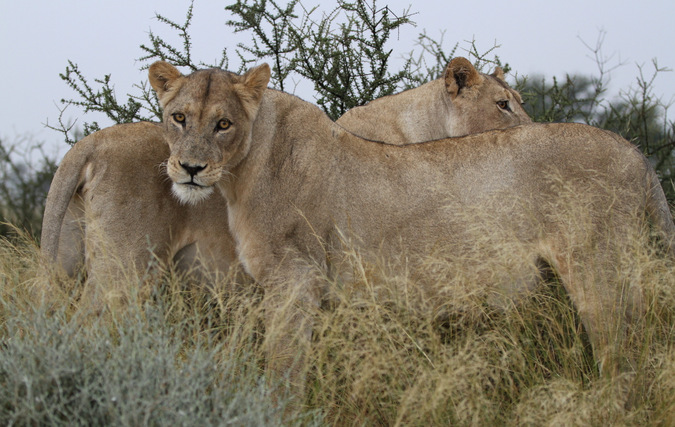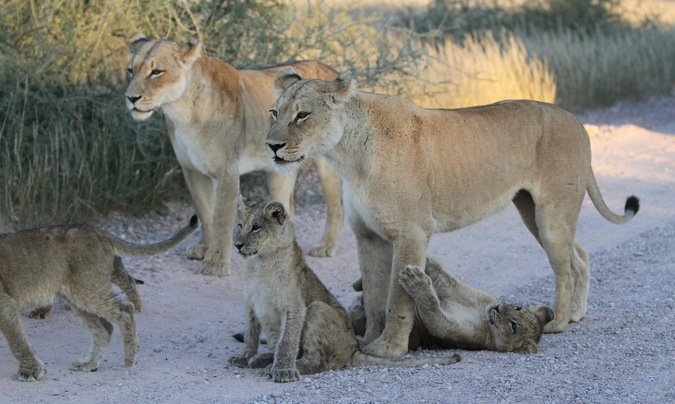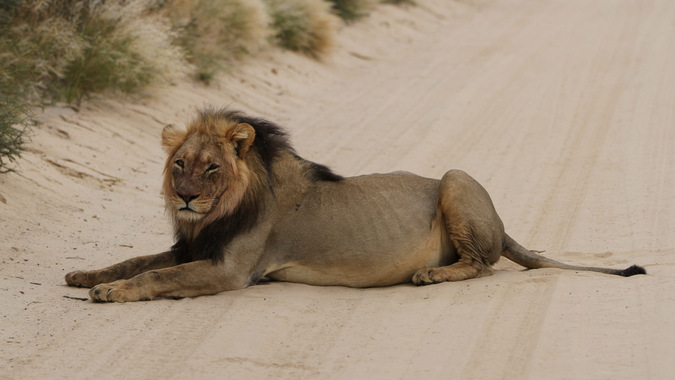The Kgalagadi Lion Project
Husband and wife team, Maya and Otto Beukes, are spearheading a groundbreaking project that will reveal critical information on the activities of the lion population in the Kgalagadi Transfrontier Park.
This Kgalagadi Lion Project forms part of the duo’s Masters research in the field of Nature Conservation and is a collaboration between CPUT and the South African National Parks (SANParks).
The project was initiated after a survey conducted in the park, which straddles the border between South Africa and Botswana, found a skewed sex ratio in favour of lion males which could result in a collapse of the park’s lion population.
Maya and Otto will be responsible for conducting a detailed study on the lion population by collecting critical information on their demography and dietary patterns.
“This information will be used to help identify the cause of the sex skew and to inform management decisions on lion conservation in the Kgalagadi Transfrontier Park,” says Maya.
The couple has been working in the park since last year and has already collected a significant amount of data and have identified 141 individual lions.
“In October 2013 four adult female lions were fitted with GPS/VHF collars by SANParks Veterinary Wildlife and Scientific Services. We will use the collars to locate prides as well as prey remains. The collars will also be used to assist with continuous following of collared individuals and their associated prides through telemetric tracking,” says Maya.
The project will run over a two year period and is being supervised by CPUT’s Dr Frans Radloff and SANParks's Dr Sam Ferreira.
If you would like to find out more about the project, please contact Maya or Otto Beukes at info@kalaharilions.co.za
You can also find updates on the Kgalagadi Lion Project on Facebook and on their website.
Kgalagadi Lions
Re: Kgalagadi Lion Project
Send Us Your Sightings
You can help us to build our identification catalogue by sending us your photographs. We will then verify your sighting and add it to the catalogue as either an individual update or a new record.
We will notify you of the particulars of the lion you have seen and add the information to the online catalogue. You can then follow future sightings of that individual lion.
When sending us your photographs what we need to know is:
Where the lion was sighted (GPS location and/or location name)
Photograph/s showing the whiskers spots (left and right side of the face)
Photograph/s showing the body (left and right side of the body)
Any additional notes e.g. what it was feeding on, time, was it in a pride or alone etc.
We know that you may not have the opportunity to gather all of this information or photographs. Therefore send us whatever you can, most importantly the photographs of the whisker spots together with the date and location of the sighting. We thank you in advance for your assistance and hope that your stay at the Kgalagadi is full of adventure and new wildlife experiences! Please feel free to view the online catalogue below. Who knows, perhaps you will come to meet one of these amazing individuals!
Email your lion photographs to otto.beukes@yahoo.com or mayabeukes@hotmail.com.
- Mel
- Global Moderator
- Posts: 27438
- Joined: Sat May 19, 2012 12:31 pm
- Country: Germany
- Location: Föhr
- Contact:
Re: Kgalagadi Lion Project
Another cat project 
Thanks for posting, Toko.
Thanks for posting, Toko.
God put me on earth to accomplish a certain amount of things. Right now I'm so far behind that I'll never die.
- nan
- Posts: 26436
- Joined: Thu May 31, 2012 9:41 pm
- Country: Switzerland
- Location: Central Europe
- Contact:
Re: Kgalagadi Lion Project
it seems a nice project, thank you Toko
names already so much names to remember
already so much names to remember 
will follow... in a first time
names
will follow... in a first time
Kgalagadi lover… for ever
https://safrounet.piwigo.com/
https://safrounet.piwigo.com/
- Mel
- Global Moderator
- Posts: 27438
- Joined: Sat May 19, 2012 12:31 pm
- Country: Germany
- Location: Föhr
- Contact:
Re: Kgalagadi Lion Project
Firstly, I'm kinda annoyed that this wasn't in my inbox although I asked them to take me on the list and they confirmed.
Secondly, I'm rather disappointed not to get more info on IDed lions.
But thanks for posting, Toks.
Secondly, I'm rather disappointed not to get more info on IDed lions.
But thanks for posting, Toks.
God put me on earth to accomplish a certain amount of things. Right now I'm so far behind that I'll never die.
Re: Kgalagadi Lion Project
Ja, they do not share anything from their database with the visitors 
But I like the frog bit
But I like the frog bit
- Lisbeth
- Site Admin
- Posts: 66704
- Joined: Sat May 19, 2012 12:31 pm
- Country: Switzerland
- Location: Lugano
- Contact:
Kalahari lions: Research sheds light on population
Kalahari lions: Research sheds light on population

© Derek Keats/
Lions are threatened across their natural range, and the Kgalagadi Transfrontier Park (KTP) straddling South Africa and Botswana is a stronghold for the species.
A research project, conducted during 2013-2015 and published in April 2017, resulted in a population estimate of 246 (237–256) lions (most precise of three count methods) in the southwestern sector of KTP, which is higher than previous estimates.
Summary
A 30% population decline and 80% range reduction over the past 20 years has resulted in there being fewer than 20,000 wild lions remaining in Africa, across 65 natural populations. Ten of these natural populations are considered strongholds – and KTP is one of these ten strongholds.
Small populations of animals that are subjected to high rates of human persecution, such as Africa’s lions, have a greater likelihood of extinction, and so understanding trends in population size, age and sex is important.
Previous research over the preceding 40 years suggested a relatively stable Kalahari lion population of 517 lions in the entire KTP, but research in 2010 off a small sample suggested a male bias of 56%, compared to previous research reflecting a female bias of 58%.
The aim of this research, therefore, was to reduce uncertainty as to population size and key variables.

© Derek Keats
The research was conducted in the dune savanna semi-desert of the southwestern sector of KTP. The area of 14,250 km² covered the Kalahari Gemsbok National Park in South Africa and a buffer strip to the east, in the Gemsbok National Park in Botswana. The researchers drove 49,784 km over 26 months, with 317 days of sampling. They counted 261 individual lions, from 1,162 sightings (of which 1,022 could be identified), and recorded 11 deaths. Of the identified lions, 74 were cubs born during the survey period.
Three methods of counting were utilised, producing the following results:
1. Mark-recapture: 246 (237-256) lions
2. Track indices: 242 (176-307) lions
3. Registration study (after removing known deaths): 250 lions
The report includes a detailed discussion about each of the three methods, including shortcomings and inaccuracies.
The full report: African Journal of Wildlife Research, B. Otto Beukes, Frans G.T. Radloff, Sam M. Ferreira.: “Estimating African lion abundance in the southwestern Kgalagadi Transfrontier Park”

© Derek Keats

© Derek Keats/
Lions are threatened across their natural range, and the Kgalagadi Transfrontier Park (KTP) straddling South Africa and Botswana is a stronghold for the species.
A research project, conducted during 2013-2015 and published in April 2017, resulted in a population estimate of 246 (237–256) lions (most precise of three count methods) in the southwestern sector of KTP, which is higher than previous estimates.
Summary
A 30% population decline and 80% range reduction over the past 20 years has resulted in there being fewer than 20,000 wild lions remaining in Africa, across 65 natural populations. Ten of these natural populations are considered strongholds – and KTP is one of these ten strongholds.
Small populations of animals that are subjected to high rates of human persecution, such as Africa’s lions, have a greater likelihood of extinction, and so understanding trends in population size, age and sex is important.
Previous research over the preceding 40 years suggested a relatively stable Kalahari lion population of 517 lions in the entire KTP, but research in 2010 off a small sample suggested a male bias of 56%, compared to previous research reflecting a female bias of 58%.
The aim of this research, therefore, was to reduce uncertainty as to population size and key variables.

© Derek Keats
The research was conducted in the dune savanna semi-desert of the southwestern sector of KTP. The area of 14,250 km² covered the Kalahari Gemsbok National Park in South Africa and a buffer strip to the east, in the Gemsbok National Park in Botswana. The researchers drove 49,784 km over 26 months, with 317 days of sampling. They counted 261 individual lions, from 1,162 sightings (of which 1,022 could be identified), and recorded 11 deaths. Of the identified lions, 74 were cubs born during the survey period.
Three methods of counting were utilised, producing the following results:
1. Mark-recapture: 246 (237-256) lions
2. Track indices: 242 (176-307) lions
3. Registration study (after removing known deaths): 250 lions
The report includes a detailed discussion about each of the three methods, including shortcomings and inaccuracies.
The full report: African Journal of Wildlife Research, B. Otto Beukes, Frans G.T. Radloff, Sam M. Ferreira.: “Estimating African lion abundance in the southwestern Kgalagadi Transfrontier Park”

© Derek Keats
"Education is the most powerful weapon which you can use to change the world." Nelson Mandela
The desire for equality must never exceed the demands of knowledge
The desire for equality must never exceed the demands of knowledge


